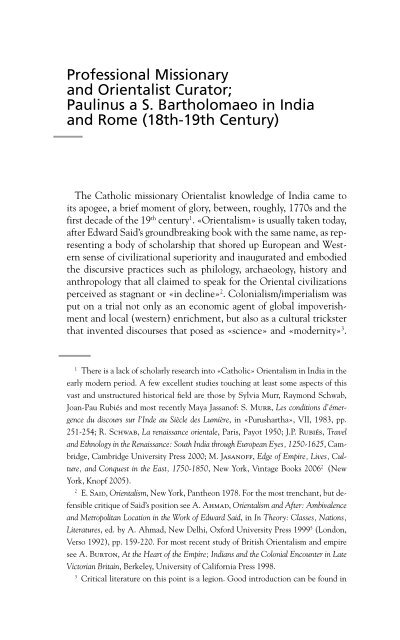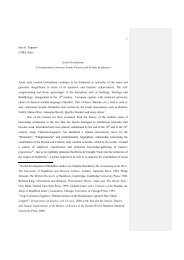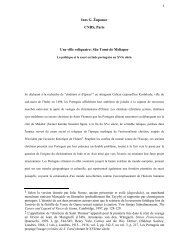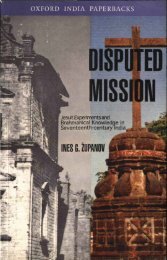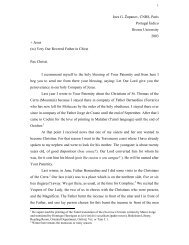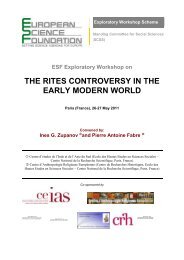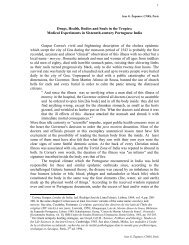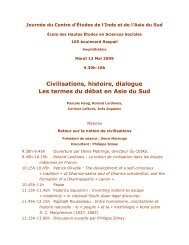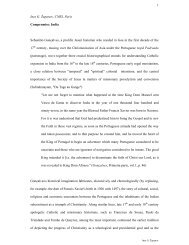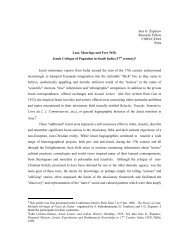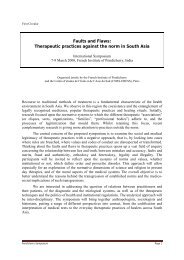Professional Missionary and Orientalist Curator ... - Ines G. Županov
Professional Missionary and Orientalist Curator ... - Ines G. Županov
Professional Missionary and Orientalist Curator ... - Ines G. Županov
You also want an ePaper? Increase the reach of your titles
YUMPU automatically turns print PDFs into web optimized ePapers that Google loves.
<strong>Professional</strong> <strong>Missionary</strong><br />
<strong>and</strong> <strong>Orientalist</strong> <strong>Curator</strong>;<br />
Paulinus a S. Bartholomaeo in India<br />
<strong>and</strong> Rome (18th-19th Century)<br />
The Catholic missionary <strong>Orientalist</strong> knowledge of India came to<br />
its apogee, a brief moment of glory, between, roughly, 1770s <strong>and</strong> the<br />
first decade of the 19 th century . «Orientalism» is usually taken today,<br />
after Edward Said’s groundbreaking book with the same name, as representing<br />
a body of scholarship that shored up European <strong>and</strong> Western<br />
sense of civilizational superiority <strong>and</strong> inaugurated <strong>and</strong> embodied<br />
the discursive practices such as philology, archaeology, history <strong>and</strong><br />
anthropology that all claimed to speak for the Oriental civilizations<br />
perceived as stagnant or «in decline» . Colonialism/imperialism was<br />
put on a trial not only as an economic agent of global impoverishment<br />
<strong>and</strong> local (western) enrichment, but also as a cultural trickster<br />
that invented discourses that posed as «science» <strong>and</strong> «modernity» .<br />
<br />
There is a lack of scholarly research into «Catholic» Orientalism in India in the<br />
early modern period. A few excellent studies touching at least some aspects of this<br />
vast <strong>and</strong> unstructured historical field are those by Sylvia Murr, Raymond Schwab,<br />
Joan-Pau Rubiés <strong>and</strong> most recently Maya Jassanof: S. Murr, Les conditions d’émergence<br />
du discours sur l’Inde au Siècle des Lumière, in «Purushartha», VII, 1983, pp.<br />
251-254; R. Schwab, La renaissance orientale, Paris, Payot 1950; J.P. Rubiés, Travel<br />
<strong>and</strong> Ethnology in the Renaissance: South India through European Eyes, 1250-1625, Cambridge,<br />
Cambridge University Press 2000; M. Jasanoff, Edge of Empire, Lives, Culture,<br />
<strong>and</strong> Conquest in the East, 1750-1850, New York, Vintage Books 2006 2 (New<br />
York, Knopf 2005).<br />
<br />
E. Said, Orientalism, New York, Pantheon 1978. For the most trenchant, but defensible<br />
critique of Said’s position see A. Ahmad, Orientalism <strong>and</strong> After: Ambivalence<br />
<strong>and</strong> Metropolitan Location in the Work of Edward Said, in In Theory: Classes, Nations,<br />
Literatures, ed. by A. Ahmad, New Delhi, Oxford University Press 1999 5 (London,<br />
Verso 1992), pp. 159-220. For most recent study of British Orientalism <strong>and</strong> empire<br />
see A. Burton, At the Heart of the Empire; Indians <strong>and</strong> the Colonial Encounter in Late<br />
Victorian Britain, Berkeley, University of California Press 1998.<br />
<br />
Critical literature on this point is a legion. Good introduction can be found in
204 <strong>Ines</strong> <strong>Županov</strong><br />
Most of the European knowledge-claims about India, in light of Said’s<br />
epistemological critique, turned suspect, uncertain <strong>and</strong> cynical <strong>and</strong><br />
provoked a lot of soul searching among the contemporary Indianists .<br />
While Said’s principal arguments have been criticized, revised <strong>and</strong><br />
continually revisited, the aim of the present article is to add a historical<br />
dimension to the European <strong>Orientalist</strong> efforts in the early modern<br />
period in India by bringing to light those <strong>Orientalist</strong> practices <strong>and</strong><br />
discourses that were not directly linked to the British empire.<br />
There is an interesting irony in the way the Indological branch of<br />
«<strong>Orientalist</strong>» disciplines came into being in Bengal in the late 18 th<br />
century British India in an intellectual circle dominated by Sir William<br />
Jones, his Asiatic Society <strong>and</strong> its journal The Asiatic Researches.<br />
The <strong>Orientalist</strong> laboratory in Calcutta proceeded by first reprocessing<br />
information acquired from their local informants <strong>and</strong> combined<br />
it with European Catholic knowledge developed from the 16 th century<br />
onwards . Catholic missionary knowledge, in particular, their<br />
linguistic achievements was welcomed if not overtly admitted .<br />
In their next move the British <strong>Orientalist</strong>s devalued the acquired<br />
tradition on the basis of a dominant European trope – perfected in<br />
Portuguese <strong>and</strong> Catholic missionary accounts – of historical «corruption»<br />
<strong>and</strong> «decadence» of Indian culture <strong>and</strong> society. Finally, once<br />
the Catholic missionary knowledge was absorbed into the interstices<br />
of the British <strong>Orientalist</strong> arguments, it was effaced from the surface of<br />
the new «science» <strong>and</strong> finally no acknowledgement was necessary.<br />
The disrepute <strong>and</strong> ultimate subalternization of the Catholic mis-<br />
G. Prakash, Against Reason. Science <strong>and</strong> the Imagination of Modern India, Princeton,<br />
Princeton University Press 1999.<br />
<br />
See, for example, Orientalism <strong>and</strong> the Postcolonial Predicament; Perspectives on<br />
South Asia, ed. by C.A. Breckenridge <strong>and</strong> P.van der Veer, Philadelphia, Pennsylvania<br />
State University Press 1993.<br />
<br />
For William Jones’s pious Christian interests in proving the existence of Mosaic<br />
ethnology <strong>and</strong> the common Aryan origins of Indian <strong>and</strong> European races see T.<br />
Trautmann, Aryans <strong>and</strong> British India, Berkeley, University of California Press 1997.<br />
<br />
The factors of success of the <strong>Orientalist</strong> scholars to inaugurate the tradition of<br />
modern Indological research compared to missionary <strong>Orientalist</strong> failure is discussed<br />
in D. Lorenzen, Marco della Tomba <strong>and</strong> the Brahmin from Banaras: Missionaries, <strong>Orientalist</strong><br />
<strong>and</strong> Indian Scholars, in «Journal of Asian Studies», LXV, 2006, pp. 113-141.<br />
He also provides an exemplary story of exchanges between lofty Jones <strong>and</strong> humble<br />
Capuchin missionary Marco della Tomba, see p. 125.
205 <strong>Professional</strong> <strong>Missionary</strong> <strong>and</strong> <strong>Orientalist</strong> <strong>Curator</strong><br />
sionary «sciences» in Enlightenment was directly linked to the transformation<br />
of the European geo-political positioning in India. The<br />
Portuguese so-called «empire» was in the late 18 th century nothing<br />
but a speck of on is it correct? the map of the subcontinent <strong>and</strong> the<br />
French «empire» never actually developed. Boaventura de Sousa<br />
Santos has recently proposed to define Portuguese colonialism as a<br />
«subaltern colonialism» for which even the rules of the game, <strong>and</strong><br />
the discourses about them, were determined post factum by the British<br />
colonialism. In the last instance, «since the seventeenth century,<br />
the history of colonialism has been written in English, not in Portuguese»<br />
. The European Catholic monarchies, therefore, decisively<br />
lost out to British colonial expansion, which also stimulated Protestant<br />
missionary inroads in the 19 th century. Another reason for the<br />
rejection of the Catholic missionary-savant was because his manner<br />
of practicing sciences was increasingly seen as atavistic, obsolete, an<br />
offshoot of a «fanatical» <strong>and</strong> «decadent» post-Tridentine Catholicism.<br />
By looking into the life <strong>and</strong> work of Paulinus a Sancto Bartholomaeo<br />
(1748-1806), born as Filip Vezdin in a Croat family in Austria<br />
who became a Discalced Carmelite <strong>and</strong> a Propag<strong>and</strong>a Fide missionary<br />
in India, my aim is to chronicle his persistent, if belated, effort<br />
to preserve Catholic missionary knowledge in Rome, in the context<br />
of the Roman church milieu, by looking after its most important archival<br />
sources assembled in the Propag<strong>and</strong>a Fide <strong>and</strong> the Museum<br />
in Velletri <strong>and</strong> by critically engaging his contemporary <strong>Orientalist</strong><br />
authors both Catholic <strong>and</strong> Protestant . Comparable to his famous<br />
<br />
B. de Sousa Santos, Between Prospero <strong>and</strong> Caliban: Colonialism, Postcolonialism,<br />
<strong>and</strong> Inter-Identit, in «Luso-Brazilian Review», XXXIX, 2, Special Issues: Portuguese<br />
Cultural Studies, Winter 2002, pp. 9-43: 11.<br />
<br />
For introduction to Paulinus see M. Jauk-Pinhak, Some Notes on the Pioneer<br />
Indologist Filip Vesdin (Paulinus a Sancto Bartholomaeo), in «Indologica Taurinensia»,<br />
XII, 1984, pp. 129-137 <strong>and</strong> Paulinus a S. Bartholomaeo, Dissertation on the Sanskrit<br />
Language, a reprint of the original Latin text of 1790 together with an introductory<br />
article, a complete English translation, <strong>and</strong> an index of sources by L. Rocher,<br />
Amsterdam, Benjamins 1977, p. XIV. The Dissertation is the introduction to Paulinus’<br />
Sanskrit grammar, the first Sanskrit grammar printed in Europe: Sidharubam seu<br />
Grammatica Samscrdamica, cui accedit Dissertatio historio-critica in linguam samscrdamicam,<br />
vulgo Sanscret dictam, in qua hujus linguae existentia, origo, praestantia, antiquitas,<br />
extensio, maternitas ostenditur, libri aliqui ea exarati critice recensentur, et simul aliquae
206 <strong>Ines</strong> <strong>Županov</strong><br />
predecessor, a Jesuit Athanasius Kircher, «the last man who knew<br />
everything about everything», Paulinus was the last important Roman<br />
missionary Indianist . The institutional support <strong>and</strong> framework<br />
provided by the Propag<strong>and</strong>a Fide <strong>and</strong> by the patronage network of<br />
the Cardinal Stefano Borgia was crucial for Paulinus’ Indological<br />
oeuvre. When Borgia invited him to organize the Indian collection<br />
in his museum in Velletri, Paulinus became, at least for two decades,<br />
the most important Indologist of the Catholic world, <strong>and</strong> Rome became<br />
the center of European Indology 10 .<br />
Before <strong>and</strong> After <strong>Missionary</strong> Fieldwork<br />
A Catholic missionary life in the early modern period is usually<br />
divided into two or three stages: 1) before entering the order <strong>and</strong><br />
being sent to the mission – a stage that makes sense in the hagiographies<br />
only if endowed by premonitions <strong>and</strong> prophetic dreams <strong>and</strong><br />
visions; 2) a subsequent life in the mission, which is a heroic period<br />
of fatigue <strong>and</strong> eventual martyrdom; 3) for some, but not all, there is a<br />
third stage upon return to Europe or to some quiet place with a possibility<br />
of writing down recollections <strong>and</strong> reflecting on the mission<br />
fieldwork.<br />
After relatively unmemorable first phase, Paulinus a S. Bartholomaeo<br />
spent thirteen years between 1776-1789 as a missionary for the<br />
Propag<strong>and</strong>a Fide in South India. He described his missionary life in<br />
the Kerala region in the Viaggio alle Indie Orientali, printed in Rome<br />
in 1796 11 . During that time he travelled extensively, learnt both Sanskrit<br />
<strong>and</strong> other local vernacular languages, <strong>and</strong> met people from the<br />
lowest fishermen to kings of Travancore. Written with a hindsight, of<br />
course, Viaggio documents as much Paulinus’s travels <strong>and</strong> his missionantiquissimae<br />
gentilium orationes liturgicae paucis attinguntur et explicantur..., Romae,<br />
Ex Typographia Sacrae Congregationis de Propag<strong>and</strong>a fide 1790 [1791].<br />
<br />
For Kircher see Athanasius Kircher; The Last Man Who Knew Everything, ed. by P.<br />
Findlen, New York-London, Routledge 2004.<br />
10<br />
For Stefano Borgia’s museological enterprise see Le quattro voci del mondo: arte,<br />
cultura e saperi nella collezione di Stefano Borgia, 1731-1804, a cura di M. Nocca, Napoli,<br />
Electa 2001.<br />
11<br />
Paulinus a S. Bartholomaeo, Viaggio alle Indie Orientali, umiliato alla Santità di<br />
N.S. Papa Pio Sesto Pontefice Massimo..., Roma, Antonio Fulgoni 1796.
207 <strong>Professional</strong> <strong>Missionary</strong> <strong>and</strong> <strong>Orientalist</strong> <strong>Curator</strong><br />
ary fieldwork as his ongoing interest in European theories <strong>and</strong> books<br />
on just about everything. Paulinus’s Viaggio belongs to a particular<br />
sub-genre of travel literature developed by the Italians <strong>and</strong> other<br />
Europeans in the course of almost three centuries of their Oriental<br />
expeditions. The narrative of this kind of travelogues is structured<br />
as a museum, with exotic «objects» classified <strong>and</strong> stored in different<br />
«disciplinary» compartments supplemented with author’s omnipresent<br />
<strong>and</strong> atemporal voice of assessment 12 .<br />
It was upon return from India 1789, Paulinus wrote, as he travelled<br />
through France «devastated» by the Revolution that he started<br />
«thinking about countries <strong>and</strong> nations that [he] saw <strong>and</strong> comparing<br />
them with Europeans, my dear compatriots» 13 . Endowed with comparative<br />
perspective, after a long fieldwork in Asia, he recognized<br />
clearly Europe’s weaknesses <strong>and</strong> achievements. Therefore, he concluded,<br />
since China <strong>and</strong> India were regions with gentile <strong>and</strong> gentle<br />
people governed by simple laws <strong>and</strong> stable governments, their religion<br />
<strong>and</strong> customs remained unchanged. Europe was, by contrast, «inconstant»<br />
<strong>and</strong> politically volatile, for which he had a historical <strong>and</strong><br />
racial explanation. What explained it was the influx of the ferocious<br />
Scythians from the cold climates at one point in Europe’s history.<br />
One of the consequences of this inbuilt mobility of the Europeans<br />
who also became conquerors of the rest of the world <strong>and</strong> thus developed<br />
excellent armies is that they acquired «one little advantage»<br />
compared to Asia. «This advantage lies in arts <strong>and</strong> sciences», in spite<br />
of the fact that, Paulinus argued, it was India where arts <strong>and</strong> sciences<br />
12<br />
See the publications of his predecessors: Giuseppe di Santa Maria Sebastiani,<br />
Prima speditione all’Indie orientali... Ordinata da Nostro Signore Aless<strong>and</strong>ro Settimo,<br />
Roma, Filippo Maria Mancini 1666; Id., Seconda speditione all’Indie orientali... Ordinata<br />
da Aless<strong>and</strong>ro Settimo di gloriosa memoria, Roma, Filippo Maria Mancini 1672;<br />
Vicenzo Maria di Santa Caterina da Siena (alias Vincenzo Maria Murchio), Il<br />
viaggio all’Indie Orientali del padre F. Vincenzo Maria di S. Caterina da Siena Procurator<br />
Gener. de’ Carm. Scalzi, con le osseruationi, e successi nel medesimo, i costumi, e riti di<br />
varie nationi, et reconditissimi arcani de’ gentili, cauati con somma diligenza da’ loro scritti,<br />
con la descrittione degli Animali Quadrupedi, Serpenti, Uccelli, Piante di quel Mondo<br />
Nuovo, con le loro virtu singolary, Diuiso in cinque libri. Opera non meno Utile, che<br />
curiosa, Venetia, Giacomo Zattoni 1678. For the general discussion see D.F. Lach,<br />
E.J. Van Kley, Asia in the Making of Europe, 3 vols., Chicago-London, University of<br />
Chicago Press 1994-1998, III (1998), A century of Advance, pp. 383-385.<br />
13<br />
Paulinus, Viaggio cit., pp. 391-392.
208 <strong>Ines</strong> <strong>Županov</strong><br />
were invented <strong>and</strong> the Europeans only perfected them. His mission<br />
upon return to Rome was, therefore, to rescue the forgotten origins<br />
of the «authentic» arts <strong>and</strong> sciences of India by distilling them from<br />
the monumenta that he brought with him <strong>and</strong> that the generations<br />
of missionaries already stored in Rome. He also thought of himself as<br />
uniquely competent for this endeavour since in India he taught himself<br />
the languages necessary for the decipherment of the most sacred<br />
<strong>and</strong> arcane books such as Sanskrit dictionaries, grammars, theological<br />
treatises <strong>and</strong> botanical <strong>and</strong> pharmacological manuals.<br />
Collecting ‘necesse est’<br />
In Rome <strong>and</strong> in Italy in particular collecting <strong>and</strong> classifying nature,<br />
antiquities, oriental manuscripts <strong>and</strong> curiosities was an established<br />
cultural institution closely connected with courtly <strong>and</strong> aristocratic<br />
values of civility 14 . Therefore, Catholic missionaries educated in<br />
Rome, from the 16 th century onwards were encouraged to collect curious<br />
objects, manuscripts, take notes <strong>and</strong> write letters from their missions.<br />
Paulinus was from the beginning a diligent collector <strong>and</strong> writer.<br />
The archives in Rome (Biblioteca Nazionale Vittorio Emanuele)<br />
contain hundreds of boxes of his various notes <strong>and</strong> letters in at least a<br />
dozen of languages <strong>and</strong> scripts 15 . Some of these documents were written<br />
for the local use <strong>and</strong> consumption such as Christian catechetical<br />
<strong>and</strong> pious texts in Malayalam, others were for the missionary use or<br />
addressed to the European audience.<br />
Most of the early Propag<strong>and</strong>a missionaries in Kerala were also keen<br />
students <strong>and</strong> collectors of manuscripts <strong>and</strong> of natural objects, such<br />
14<br />
Scientific culture that emerged in the early modern period was traversed in<br />
important ways with the culture of collecting. According to Paula Findlen’s admirable<br />
study of the late Renaissance naturalists, sciencia flourished in «civil» spaces<br />
well provided with specimens coming from all over the world. P. Findlen, Possessing<br />
Nature: Museums, Collecting <strong>and</strong> Scientific Culture in Early Modern Italy, Berkeley,<br />
University of California Press 1994. On collecting <strong>and</strong> collectors see also works by<br />
K. Pomian, Collectionneurs, amateur et curieux: Paris, Venise, XVI e -XVIII e siècle, Paris,<br />
Gallimard 1987.<br />
15<br />
The letters Paulinus left behind in his archives are in Latin, Italian, Portuguese,<br />
German, English <strong>and</strong> Malayalam. Biblioteca Nazionale Vittorio Emanuele (BNVE),<br />
Rari e manoscritti, Fondi Minori, Santa Maria della Scala, 22, 30, 33, 37, 38.
209 <strong>Professional</strong> <strong>Missionary</strong> <strong>and</strong> <strong>Orientalist</strong> <strong>Curator</strong><br />
as Vicenzo Maria di Santa Caterina da Siena <strong>and</strong> Matteo di San<br />
Giuseppe, an expert Arabist <strong>and</strong> a botanist who helped Dutch comm<strong>and</strong>er<br />
of Malabar Hendrik Adriaan van Rheede tot Drakenstein<br />
(1637-1691) with his monumental botanical book Hortus Indicus<br />
Malabaricus (Amsterdam between 1678 <strong>and</strong> 1703) 16 .<br />
Paulinus also studied oriental languages in Rome before his arrival<br />
to Kerala <strong>and</strong> upon his return became himself a professor of Oriental<br />
languages at the Propag<strong>and</strong>a Mission Seminary. The collection of<br />
facts about nature <strong>and</strong> languages in India was an important part of<br />
the Carmelite mission enterprise in Kerala. This is evident from the<br />
titles of printed books <strong>and</strong> manuscripts the missionaries sent back<br />
or published after returning to Europe. In this respect they were not<br />
unique, since most of the <strong>Orientalist</strong>s in the 18 th century were both<br />
interested in botany as well as languages. Moreover, the study of nature<br />
<strong>and</strong> the study of languages followed the same line of reasoning<br />
at least in terms of underst<strong>and</strong>ing morphological <strong>and</strong> etymological<br />
structures 17 . William Carey, a Baptist missionary, <strong>Orientalist</strong> <strong>and</strong> a<br />
professor of Oriental languages in the Fort William College in Calcutta<br />
was also an amateur botanist who edited <strong>and</strong> published William<br />
Roxburgh’s Flora Indica; or Descriptions of Indian Plants 18 .<br />
William Jones was also interested in botany, which was his «principal<br />
amusement» together with «the conversation with the pundits,<br />
with whom I talk fluently in the language of the Gods» 19 . The two<br />
16<br />
See I.G. <strong>Županov</strong>, ‘Amateur’ Naturalist <strong>and</strong> ‘<strong>Professional</strong>’ <strong>Orientalist</strong>, Paulinus a<br />
Sancto Bartolomaeo in Kerala <strong>and</strong> Rome (18th-19th c.), in «Revista de Cultura/Review<br />
of Culture», XX, 2006, pp. 77-101.<br />
17<br />
P.B. Salmon, The Beginnings of Morphology; Linguistic Botanizing in the 18 th century,<br />
in «Historiographia Linguistica», III, 1974, pp. 313-339. M. Olender, Les langues<br />
du Paradis, Aryens et Sémites: un couple providentiel, Paris, Gallimard-Le Seuil<br />
1989, p. 20.<br />
18<br />
William Carey edited <strong>and</strong> published Dr. W. Roxburgh, ‘Flora Indica’; or Descriptions<br />
of Indian Plants..., 2 vols., Serampore, Mission Press 1820-1824. Roxburgh<br />
(1751-1815) was an eminent botanist, horticulturalist, <strong>and</strong> physician. From 1793<br />
until his death, he was the Superintendent of the Botanic Garden in Calcutta. In<br />
the Viaggio, Paulinus mentioned that he British were planning to publish a work<br />
on Indian plants, but he doubted that they would have had enough money for that<br />
Viaggio cit., p. 265.<br />
19<br />
Quoted in R. Rocher, British Orientalism in the Eighteenth Century, in Orientalism<br />
<strong>and</strong> the Postcolonial Predicament; Perspectives on South Asia, ed. by C.A. Brecken-
210 <strong>Ines</strong> <strong>Županov</strong><br />
contemporaries Paulinus, a Catholic missionary in Kerala <strong>and</strong> William<br />
Jones, an enlightened <strong>Orientalist</strong> in Calcutta were, therefore,<br />
each within their own cultural milieu chasing the same scientific<br />
paradigm <strong>and</strong> the same Christian teleology. They both tried to preserve<br />
their vision of the Christian world guaranteed by the Bible <strong>and</strong><br />
confirming the structure of the Mosaic ethnology.<br />
One of the crucial differences between these two early scholars of<br />
India was in the manner in which they h<strong>and</strong>led <strong>and</strong> organized their<br />
«research» data <strong>and</strong> material evidence, <strong>and</strong> the cultural <strong>and</strong> social<br />
context in which the constituted data were available for scholarly<br />
consumption. For Jones <strong>and</strong> other <strong>Orientalist</strong>s, the newly conquered<br />
Bengal <strong>and</strong> its capital Calcutta provided a fertile space for setting up<br />
all the institutions indispensable for scholarly activities – a learned<br />
society, a journal, a college <strong>and</strong> an informal, ever growing pool of local<br />
literati ready to be employed 20 .<br />
Paulinus a Sancto Bartolomaeo, on the other h<strong>and</strong>, rarely had the<br />
opportunity of enjoying <strong>and</strong> profiting from a closely-knit scientific<br />
community during his stay in India. Residing in India resembled<br />
more a fieldwork period in which he collected materials rather than<br />
studying them in depth. In a way, he was collecting specimens for his<br />
future museum – his printed books. Knowledge of India was therefore<br />
to be constituted outside of its borders, somewhere in a fixed <strong>and</strong><br />
framed public space of the Papal court.<br />
Museum collections <strong>and</strong> «authentic» translations<br />
It was upon return to Europe in 1789 that Paulinus had a chance to<br />
put his notes in order <strong>and</strong> think about a larger picture for his scholarly<br />
ambitions. For the next seventeen years he published 26 (or more)<br />
books <strong>and</strong> articles on a wide variety of topics – from catalogues of<br />
various museum collections, learned treatises <strong>and</strong> grammars to short<br />
polemical papers in comparative linguistics. Those scattered notes in<br />
Paulinus’s boxes (scatole), today in the Biblioteca Nazionale Vittorio<br />
ridge <strong>and</strong> P. van der Veer, Philadelphia, Pennsylvania State University Press 1993,<br />
pp. please, put all the pages of the article: 232.<br />
20<br />
The factors of success of the <strong>Orientalist</strong> scholars to inaugurate the tradition of<br />
modern Indological research compared to missionary <strong>Orientalist</strong> failure is discussed<br />
in Lorenzen, Marco della Tomba cit.
211 <strong>Professional</strong> <strong>Missionary</strong> <strong>and</strong> <strong>Orientalist</strong> <strong>Curator</strong><br />
Emanuele, took shape under various titles <strong>and</strong> topics. Paulinus sifted<br />
through, classified, pruned <strong>and</strong> prepared for print documents <strong>and</strong> materials<br />
from his prodigious manuscript collection, including his fieldwork<br />
diaries. Within five years that he spent in Rome as a professor<br />
of Oriental Languages at the Propag<strong>and</strong>a Fide Mission seminary, he<br />
had managed to publish eight books: a Sanskrit grammar, Sidharubam<br />
seu Grammatica Samscrdamica (1790), a synthetic treatise on religious<br />
<strong>and</strong> civil organization in Brahmanic India, Systema Brahmanicum Liturgicum,<br />
Mythologicum, Civile, ex Monumentis Indicis Musei Borgiani<br />
Velitris, Dissertationibus historico-criticis (1791), a history of Christianity<br />
in India India Orientalis Christiana (1794), a few works on various<br />
South Asian alphabets <strong>and</strong> proverbs 21 , <strong>and</strong> two catalogues/inventories<br />
of Oriental manuscripts <strong>and</strong> objects, one for the Propag<strong>and</strong>a Fide<br />
<strong>and</strong> the other for the Museum in Velletri 22 .<br />
His travelogue, Viaggio alle Indie Orientali was not simply an effort<br />
at capturing a larger public, but also a way of quickly storing information<br />
that Paulinus probably knew he would not have enough time in<br />
near future to organize himself <strong>and</strong> that may thus be forgotten in the<br />
archives. Publishing Viaggio was also a way of inscribing himself onto<br />
a long list of travelogue writers through India, <strong>and</strong> to remind his readers<br />
of his first h<strong>and</strong> authority in things Indian.<br />
The most important way in which all these scattered fragments<br />
were brought together is translation. Translation was also the key to<br />
discovering both origins <strong>and</strong> the history of an object or a concept.<br />
Thus Paulinus wrote in the Viaggio, «With incredible inconvenience<br />
(fastidio) <strong>and</strong> labor (pena) I reunited these Indian Malabar names,<br />
21<br />
Alphabeta Indica, id est Granthamicum seu Sanscrdamico-Malabaricum, Indostanum<br />
sive Vanarense, Nagaricum vulgare et Talinganicum, Romae, Ex Typographia Sacrae<br />
Congregationis de Propag<strong>and</strong>a fide 1791, p. 24; De veteribus Indis dissertatio, in<br />
qua cavillationes auctoris Alphabeti Tibetani (A.A. Giorgi) castigatur, Romae, Antonius<br />
Fulgonius 1795, p. 54; Centum Adagia Malabarica cum textu originali et versione latina:<br />
nunc primum in lucem edita a Paulino a Sancto Bartholomaeo, Romae, Antonius Fulgonius<br />
1791, p. 12.<br />
22<br />
Paulinus a S. Bartholomaeo, Examen Historico-criticum Codicum Indicorum<br />
Bibliothecae Sacrae Congregationis de Propag<strong>and</strong>a Fide..., Romae, Ex Typographia Sacrae<br />
Congregationis de Propag<strong>and</strong>a fide 1792, p. 80; Id., Musei Borgiani Velitris codices<br />
avenses, peguani, siamici, malabarici, indostani, animadvesionibus historico-criticis castigati<br />
et illustrati. Accedunt monumenta inedita et Cosmogonia indico-tibetana..., Romae,<br />
Antonius Fulgonius 1793.
212 <strong>Ines</strong> <strong>Županov</strong><br />
with the names in Latin <strong>and</strong> Portuguese of so many Indian simples<br />
(plants) in order to provide the key to Malabar Botany to the amateurs<br />
of this science 23 ». Names, of course, came straight from the<br />
dictionaries <strong>and</strong> texts, written or published by other missionaries in<br />
India <strong>and</strong> manuscripts provided by his local informants in vernacular<br />
languages <strong>and</strong> in Sanskrit.<br />
Sanskrit<br />
Just like all 18 th century <strong>Orientalist</strong>s, Paulinus was obsessed with<br />
Sanskrit, the scholarly language (la lingua dotta) of the Indians. In<br />
Sidharubam seu Grammatica Samscrdamica, his first Sanskrit grammar<br />
printed only a year after his return to Rome in 1790, Paulinus wrote<br />
a veritable panegyric to «this language of the ancient sages of India».<br />
Without mentioning the name, he quoted William Jones’s famous<br />
statement that Sanskrit was more perfect than Greek <strong>and</strong> more copious<br />
than Latin 24 . For Paulinus, Sanskrit was a kind of omnimedium for<br />
storing <strong>and</strong> generating culture. First of all, it «possessed all conceivable<br />
words», it had «unlimited abundance of nouns <strong>and</strong> verbs» <strong>and</strong><br />
it was «the most adequate medium for discussing any subject whatsoever»<br />
25 . He was not the fist Catholic missionary who admired Sanskrit<br />
<strong>and</strong> dreamt of making it a perfect receptacle for Christian message,<br />
often called a «local Latin» 26 . In South India, Roberto Nobili<br />
(1577-1656) in the early seventeenth century started writing Christian<br />
literature in Sanskrit <strong>and</strong> in Sanskritized Tamil 27 . Independently,<br />
Heinrich Roth (1620-1668), a Jesuit missionary at the Mughal court,<br />
was equally enthusiastic <strong>and</strong> tried to enlist to the cause of Sanskrit<br />
the famous Jesuit polyhistor Athanasius Kircher in Rome. Kircher<br />
23<br />
Paulinus, Viaggio cit., p. 366.<br />
24<br />
Id., Dissertation on the Sanskrit Language cit., p. 98.<br />
25<br />
Ibid., pp. 102-103.<br />
26<br />
A Jesuit dream of finding a perfect language receptacle for the Christian message<br />
made the missionaries susceptible to all languages cultivated by the learned<br />
non-Christian literati. The Jesuits at the Mughal court singled out Persian while<br />
those in China thought that M<strong>and</strong>arin qualified to become the language of the Mass<br />
for the Chinese.<br />
27<br />
I.G. <strong>Županov</strong>, Disputed Mission, Jesuit Experiments <strong>and</strong> Brahmanical Knowledge<br />
in Seventeenth Century India, New Delhi, Oxford University Press 1999.
213 <strong>Professional</strong> <strong>Missionary</strong> <strong>and</strong> <strong>Orientalist</strong> <strong>Curator</strong><br />
received bundles <strong>and</strong> bundles of information from all over the world<br />
<strong>and</strong> some made it into his printed works. While he included five<br />
plates with Sanskrit alphabet into his China Illustrata, the main text<br />
of Roth’s Sanskrit grammar remained lost in the archives of the Collegio<br />
Romano 28 . William Jones, who looked down on Catholic missionaries<br />
<strong>and</strong> their conversion methods, unknowingly agreed with<br />
them when he stated that the Muselmàns <strong>and</strong> Hindus could be easily<br />
converted if certain biblical chapters such as the Prophets, «particularly<br />
of Isaiah» <strong>and</strong> one of the Gospels were translated into Sanskrit<br />
<strong>and</strong> Persian. Such translations may cause «a great revolution [read<br />
conversion]» 29 .<br />
Sanskrit was, therefore, a repository <strong>and</strong> a witness of the Brahmanical<br />
high «learning, cultivation of sciences <strong>and</strong> arts [...] multiplicity<br />
of philosophic <strong>and</strong> religious sects, a variety of castes <strong>and</strong> trades, a<br />
refinement of life, <strong>and</strong> a most intensive study of logic <strong>and</strong> metaphysics»<br />
30 . It was also a mother language of all Indian vernaculars such<br />
as, according to Paulinus, Ceilanica, Tamulica, Malabarica, Canara,<br />
Maràshda, Telinga, Bengalina, Devanagirca, Guzaratica, Nepalese <strong>and</strong> of<br />
two languages that migrated out of India such as Zendica (in Persia)<br />
<strong>and</strong> the Gypsy vernacular (in Europe) 31 . In the same way, Paulinus<br />
continued, Latin was the mother of Italian, French, Spanish <strong>and</strong> Portuguese.<br />
That is the reason why the one who knows Sanskrit can easily<br />
learn all other vernaculars 32 . In addition, Paulinus proved in numerous<br />
convoluted etymological derivations that Sanskrit had also at<br />
one point or another penetrated «Greece <strong>and</strong> Latium» 33 . Here again,<br />
Paulinus takes a combative st<strong>and</strong>, in spite of the fact that his own<br />
28<br />
Roth’s grammar was discovered in Bibioteca Nazionale Vittorio Emanuele in<br />
Rome in 1976 by Arnuld Camps, O.F.M, see Lach, III, 2, plate 129. A. Kircher,<br />
China monumentis, qua sacris qua profanis, nec non variis naturae et artis spectaculis...<br />
illustrata, Amsterdam, Jacob van Meurs 1667.<br />
29<br />
W. Jones, On the Gods of Greece, Italy <strong>and</strong> India, written in 1784, <strong>and</strong> since revised<br />
by the President, in Asiatic Researches, or Transactions of the Society Instituted in Bengal,<br />
for Inquiring into the History <strong>and</strong> Antiquities, the Arts, Sciences, <strong>and</strong> Literature of Asia,<br />
20 vols., Calcutta, Manuel Cantopher 1788-1839 [printed verbatim from the Calcutta<br />
edition, London, J. Sewell et al. 1799-1839], I, p. 275.<br />
30<br />
Paulinus, Dissertation on the Sanskrit Language cit., p. 103.<br />
31<br />
Id., Viaggio cit., pp. 258-263.<br />
32<br />
Id., Dissertation on the Sanskrit Language cit., pp. 124-125.<br />
33<br />
Ibid., p. 113.
214 <strong>Ines</strong> <strong>Županov</strong><br />
conclusions that India, not Egypt or Greece, was the most antique<br />
civilization was not so different from, neither irreconcilable with,<br />
other scholars <strong>and</strong> writers such as William Jones whose texts he knew<br />
well. By 1798, Paulinus’s comparative method produced one of the<br />
first studies on the kinship of Indo-European languages 34 . In his De<br />
antiquitate et affinitate linguae Zendicae, Samscrdamicae et Germanicae<br />
dissertatio, Paulinus juxtaposes linguistic forms in Sanskrit, Avestan<br />
<strong>and</strong> German in order to prove the existence of kinship between these<br />
languages 35 . In fact, Paulinus set out to prove with examples Jones’s<br />
famous claim in 1786 of the common origin of Greek, Latin <strong>and</strong> Sanskrit,<br />
but it was not until 1802 before he finally came up with decisive<br />
pronouncement on the issue 36 . Thus, he wrote in his De latini sermonis<br />
origine, both Sanskrit, Zend <strong>and</strong> Latin possess between them «an intimate<br />
affinity» <strong>and</strong> resemble as «one egg to another» 37 .<br />
Sanskrit, in Paulinus’s opinion, contained truth on the one h<strong>and</strong>,<br />
<strong>and</strong> many lies on the other. As a repository of the Brahmanical high<br />
learning, it also wove into it monstrous «fables» <strong>and</strong> corrupted the<br />
pristine message (presumably Christian, of course). Paulinus was in<br />
34<br />
Jauk-Pinhak, Some Notes cit., p. 136.<br />
35<br />
Paulinus a S. Bartholomaeo, De antiquitate et affinitate linguae Zendicae, Samscrdamicae<br />
et Germanicae dissertatio..., Patavii, Typis seminarii 1798 [1799].<br />
36<br />
The similarity between Latin <strong>and</strong> Sanskrit was noticed very early. Filippo Sassetti<br />
who visited India between 1583 <strong>and</strong> 1588 described Sanskrit as a language with<br />
a well ordered grammar <strong>and</strong> containing words that resembled Italian. He also hinted<br />
at the fact that it was perhaps India the cradle of all languages. D.F. Lach, Asia in the<br />
Making of Europe, 3 vols., Chicago-London, University of Chicago Press 1965-1977,<br />
II (1970), 3, p. 520. French Jesuits such as J.F. Pons, J. Calmette <strong>and</strong>, in particular,<br />
P.-G. Coeurdoux were some of the most learned Sanskritists of the first half of the<br />
18 th century. Coeurdoux may have been the first to report in 1767 on the close family<br />
resemblance between Greek, Latin <strong>and</strong> Sanskrit terms. This letter was sent to<br />
the members of the Académie Royal des Inscription et des Belles-Lettres in Paris.<br />
S. Murr, L’Inde philosophique entre Bossuet et Voltaire, l’indologie du Père Coeurdoux;<br />
stratégies, apologétique et scientificité, 2 vols., Paris, Ecole française d’Extrême-Orient<br />
1987, II, p. 29.<br />
37<br />
Jauk-Pinhak, Some notes cit. Paulinus a S. Bartholomaeo, De latini sermonis<br />
origine et cum orientalibus linguis connectione dissertatio..., Romae, Fulgonius 1802. A<br />
ten page manuscript copy of the article with slight differences can be found in Rome,<br />
BNVE, Rari e manoscriti, Fondi minori, Santa Maria della Scala, 36 (C), p. 2. The<br />
date on the manuscript is 1801. There is another copy ibid., 34, pp. 58-77.
215 <strong>Professional</strong> <strong>Missionary</strong> <strong>and</strong> <strong>Orientalist</strong> <strong>Curator</strong><br />
particular interested in underst<strong>and</strong>ing the origin <strong>and</strong> truth of Indian<br />
religious <strong>and</strong> philosophical ideas <strong>and</strong> he was sure that the Sanskrit<br />
<strong>and</strong> the ancient books were the keys to the enigma. His efforts were<br />
not always appreciated, especially by the British <strong>Orientalist</strong>s who denounced<br />
him as a fraud.<br />
Alex<strong>and</strong>er Hamilton thought that Paulinus’s Sanskrit dictionary,<br />
Amarasinha printed in 1798, was «a dictionary of the Malabar idiom,<br />
which bears the same relation to the Sanskrit that Italian does to<br />
Latin» 38 . It is clear today that the misunderst<strong>and</strong>ing came from the<br />
fact that Paulinus transcribed Sanskrit words from the Grantha script<br />
<strong>and</strong> under influence of the Dravidian phonology <strong>and</strong> into the Italian<br />
orthography. On the other h<strong>and</strong>s, the British Sanskritists in Calcutta<br />
learnt Sanskrit from their Bengali pundits. Paulinus was aware that<br />
the transcription <strong>and</strong> transliteration of Indian languages was a problem.<br />
«The Europeans, Arabs, Persians, Greeks who do not underst<strong>and</strong><br />
Indian language, try to pronounce or write Indian words with<br />
the same corruption as dictated by their spirit (genío) <strong>and</strong> secondly<br />
according to the pronunciation of their country (patria) which leads<br />
to another corruption that changes <strong>and</strong> transforms <strong>and</strong> corrupts in<br />
everything <strong>and</strong> in part the true native Indian name» 39 . He castigated<br />
in particular the French geographers such as Jean Baptiste Bourguignon<br />
d’Anville (1697-1782), Guillaume de l’Isle (1675-1726), Andrea<br />
Cellario <strong>and</strong> the French Capuchin François Marie de Tours (d.<br />
1709) for daring to write about India ignorant as they were of the<br />
correct spelling of the names. Paulinus, of course, was intended to<br />
correct all the names bastardized by the foreigners (stranieri) <strong>and</strong><br />
travelers (viaggiatori) <strong>and</strong> to st<strong>and</strong>ardize their pronunciation according<br />
to the Italian orthography. Thus, he claimed Corom<strong>and</strong>el should<br />
be spelled Ciòlam<strong>and</strong>ala.<br />
Taking up William Jones’s opinion that «[our] English alphabet <strong>and</strong><br />
orthography are disgracefully, <strong>and</strong> almost ridiculously, imperfect»,<br />
Paulinus added his own more devastating appraisal. «The English alphabet<br />
is not only imperfect but plainly ridiculous when it comes to<br />
expressing Indian nouns, they horribly corrupt them when writing<br />
them in that alphabet» 40 . But, of course, the way European Oriental-<br />
38<br />
Trautmann, Aryans <strong>and</strong> British India cit., p. 36; A. Hamilton, title?, in «Review<br />
of Asiatick Researches», VI, 1802, pp. 30-310.<br />
39<br />
Paulinus, Viaggio cit., p. 17.<br />
40<br />
W. Jones, A dissertation on the Orthography of Asiatick Words in Roman Letters by
216 <strong>Ines</strong> <strong>Županov</strong><br />
ist history unfolded, these linguistic decisions were not left to Italians.<br />
One point of similarity between the British <strong>and</strong> the Catholic <strong>Missionary</strong><br />
<strong>Orientalist</strong>s is their effort at preserving the relics of the Indian<br />
past. In fact, the preservation of the Indian ancient life <strong>and</strong> wisdom<br />
was the prime task of the Brahmans, who according to the European<br />
<strong>Orientalist</strong>s not only did a bad job, but also hid <strong>and</strong> distorted this<br />
pristine knowledge, which would, they hoped, confirm the Biblical<br />
chronology. It was often repeated that the Brahmans who new by<br />
heart the Vedas <strong>and</strong> were able to recite them did not necessarily underst<strong>and</strong><br />
the meanings. This is why the Brahmans had to be replaced<br />
<strong>and</strong> the first stage in this process was to take control of their learned<br />
language <strong>and</strong> their books.<br />
Replacing Brahmans<br />
The first to take professional interest in Indian «pagan» books <strong>and</strong><br />
to learn <strong>and</strong> teach vernacular languages of India were Jesuits 41 . The<br />
famous method of accommodation, first employed in India by Roberto<br />
Nobili, one of the first Jesuit <strong>Orientalist</strong>s, in the early 17 th century<br />
was geared to displace Brahmans through imitation or partial<br />
strategic mimesis. He not only fashioned his public persona in the<br />
image of a Brahman, but he also «translated» Christian texts into<br />
Tamil, Sanskrit <strong>and</strong> Telugu <strong>and</strong> practically invented a «new Christian»<br />
idiom for his neophytes 42 .<br />
Compared to Nobili, Paulinus st<strong>and</strong>s in between the «corrective»<br />
missionary Orientalism <strong>and</strong> «scientific» British Orientalism in Calcutta.<br />
Paulinus’s printed texts such as his Sanskrit dictionary <strong>and</strong><br />
grammar, his Systema Brahmanicum <strong>and</strong> some other books, could be<br />
seen as useful to future missionaries, but they were also texts inspired<br />
by the Asiatic Researches <strong>and</strong> by other <strong>Orientalist</strong> scholars in India<br />
<strong>and</strong> Europe. Moreover, the new type of <strong>Orientalist</strong> knowledge moved<br />
the President, in Asiatic Researches, or Transactions of the Society Instituted in Bengal cit.,<br />
I, p. 13. Paulinus, Examen Historico-criticum cit., p. 6; Id., Dissertation on the Sanskrit<br />
Language cit., p. 92.<br />
41<br />
I.G. <strong>Županov</strong>, <strong>Missionary</strong> Tropics: the Catholic Frontier in India (16th-17th Century),<br />
Ann Arbor, University of Michigan Press 2005.<br />
42<br />
<strong>Županov</strong>, Disputed Mission cit.
217 <strong>Professional</strong> <strong>Missionary</strong> <strong>and</strong> <strong>Orientalist</strong> <strong>Curator</strong><br />
increasingly away from the sites of «data collection». «The centers of<br />
calculation» as far as Indological sciences were concerned, moved to<br />
the nineteenth century Europe 43 .<br />
Well, Paulinus obviously also moved in the right direction when<br />
he came back to Rome, where museums <strong>and</strong> collections of antiquities<br />
were in fashion <strong>and</strong> had as their patrons some of the richest <strong>and</strong> most<br />
influential Papal officials, the most enterprising of whom was probably<br />
Cardinal Stefano Borgia. He was an emblematic figure combining<br />
in his person all qualities of an eighteenth century Roman mecenate.<br />
He was from a rich aristocratic family, himself an amateur antiquarian<br />
<strong>and</strong> historian as well as a talented Papal administrator. On his family<br />
property in Velletri, Borgia founded a Museum of antiquities <strong>and</strong><br />
relics of the «ancient» civilizations such as coins, manuscripts <strong>and</strong><br />
artwork. This museum was open to all learned men, of all creed, of<br />
his time such as Jacob Georg Christian Adler <strong>and</strong> Georg Zoega, <strong>and</strong><br />
many other. Goethe visited the place on February 22, 1787 <strong>and</strong> described<br />
it in his Italienische Reise (1829) 44 . It was with Borgia’s encouragement<br />
<strong>and</strong> protection, since he was an influential member of the<br />
Propag<strong>and</strong>a Fide that Paulinus was able to work on his publications.<br />
More importantly, the Velletri Museum provided a space for various<br />
classical <strong>and</strong> antiquity scholars to meet <strong>and</strong> exchange ideas <strong>and</strong><br />
compare notes. Paulinus’s comparative perspective was further developed<br />
through the access to materials <strong>and</strong> scholars working on Coptic,<br />
Egyptian, Greek <strong>and</strong> Roman archeology <strong>and</strong> literature. His printed<br />
books are full of references to various Velletri collections <strong>and</strong> catalogues.<br />
Paulinus belonged, therefore, to a community of scholars, all<br />
of whom belonged to Stefano Borgia’s patronage network. It is clear<br />
that their common interest <strong>and</strong> expertise in antiquities <strong>and</strong> classical<br />
learning defined the topics <strong>and</strong> agreed-upon set of procedures 45 . For<br />
43<br />
For the notion of «centers of calculation» see B. Latour, Science in Action:<br />
How to Follow Scientists <strong>and</strong> Engineers Through Society, Cambridge (mass.), Harvard<br />
University Press 1987.<br />
44<br />
J.W. von Goethe, Italian Journey, 1786-1788, ed. by W.H. Auden <strong>and</strong> E. Mayer,<br />
New York, Penguin 1992.<br />
45<br />
Paula Findlen described a similar situation in her article on the emergence of<br />
natural history as a discipline from the perspective of community formation, cfr.<br />
The Formation of a Scientific Community: Natural History in Sixteenth-Century Italy, in<br />
Natural Particulars, Nature <strong>and</strong> the Disciplines in Renaissance Europe, ed. by A. Grafton<br />
<strong>and</strong> N. Siraisi, Cambridge (mass.), MIT Press 1999, pp. 369-400.
218 <strong>Ines</strong> <strong>Županov</strong><br />
example, the lingua franca of their enterprise was Latin, rather then<br />
the vernacular Italian. «Borgia’s» scholars were also often employed<br />
in cataloguing, ordering, classifying <strong>and</strong> describing the collections<br />
rather then «speculating» about larger philosophical <strong>and</strong> theological<br />
issues of the day.<br />
The purpose of the material sources stored in Papal libraries, museums<br />
<strong>and</strong> books that nourished Roman scholarship was part of an ecumenical<br />
<strong>and</strong> universal Catholic mission of which Borgia <strong>and</strong> some<br />
other «enlightened» cardinals dreamt of on the eve of the French<br />
Revolution. However, in spite of excellent materials to which he had<br />
access in the Roman archives, Paulinus did not have a sufficiently<br />
numerous community of Indologists in Rome <strong>and</strong> in Italy in general.<br />
Moreover, his archival <strong>and</strong> comparativist work was torn between two<br />
differently articulated projects. For Borgia <strong>and</strong> his Catholic universal<br />
mission, Paulinus was a «conservationist» or curator of documents<br />
<strong>and</strong> objects that were to prove what the Church already knew, <strong>and</strong><br />
prevent theories that would argue against the basic Catholic dogmas.<br />
At the same time, as an <strong>Orientalist</strong>, Paulinus «belonged» to an international<br />
community of scholars, most of whom were Christian, but<br />
prided themselves on scientific, secular epistemologies <strong>and</strong> mistrusted<br />
in particular Catholic missionaries in India. In a hostile comment,<br />
Anquetil Duperron remarked that for Paulinus «all his science comes<br />
from the Propag<strong>and</strong>a Fide library, Museum of Cardinal Borgia, from<br />
F. Hanxleden [the Sanskrit grammar] <strong>and</strong> from Asiatick Researches in<br />
Calcutta, whether he underst<strong>and</strong>s it or not» 46 . Paulinus felt snubbed<br />
by the British <strong>and</strong> French <strong>Orientalist</strong>s, but he avidly read what they<br />
wrote <strong>and</strong> he responded to them in his own works. Besides pointing<br />
to their ignorance <strong>and</strong> errors, he also applauded <strong>and</strong> invited them to<br />
come <strong>and</strong> consult his books in Rome 47 .<br />
None of the European <strong>Orientalist</strong> came to Rome, very few read<br />
his books <strong>and</strong> after his death in 1806 <strong>and</strong> the dispersal of the Borgia<br />
Museum in 1812, Paulinus’s books sank into oblivion. Rome in general<br />
became a backwater on the map of the nineteenth-century Ori-<br />
46<br />
Paulinus a S. Bartholomaeo, Voyage aux Indes orientales par le P. Paulin de S.<br />
Bathélemy, Missionnaire; traduit de l’Italian par M***[Marchesan] Avec les observations<br />
de MM Anquetil du Perron, J.R. Forster et Silvestre de Sacy; Et une dissertation de M.<br />
Anquetil sur la propriété individuelle et foncière dans l’Inde et en Égypte, 3 vols., Paris,<br />
Tourneisen fils 1808, III, p. 439.<br />
47<br />
Id., Dissertation on the Sanskrit Language cit., p. 92.
219 <strong>Professional</strong> <strong>Missionary</strong> <strong>and</strong> <strong>Orientalist</strong> <strong>Curator</strong><br />
entalist scholars. With a loss of political autonomy through French<br />
invasion <strong>and</strong> the internal «revolutions», there was no more patronage<br />
network for missionary Indianists. A new kind of professional<br />
<strong>Orientalist</strong>s that appeared in the middle of the 19 th century such as<br />
Count Angelo de Gubernatis <strong>and</strong> Giuseppe Tucci had more in common<br />
with British, German <strong>and</strong> French <strong>Orientalist</strong>s than with their<br />
immediate Catholic missionary predecessors like Paulinus 48 .<br />
<strong>Ines</strong> G. <strong>Županov</strong><br />
48<br />
A. De Gubernatis, Matériaux pour servir à l’histoire des études orientales en Italie,<br />
Paris-Florence-Rome-Turin, Leroux 1876. See an interesting view of his «Italian»<br />
<strong>Orientalist</strong> predecessors. While he rejected Paulinus (whom he mistakenly <strong>and</strong><br />
sneeringly designated as «italianised hungarian») on the basis of his unhelpful <strong>and</strong><br />
confused ideas <strong>and</strong> obstinate character, he extolled some other «pure» Italian travelers-<strong>Orientalist</strong>s<br />
<strong>and</strong> missionaries, such as Filippo Sassetti (16 th century) <strong>and</strong> Marco<br />
della Tomba (18 th century).


